|
Welcome To
GUNUNG MULU NP
PAGE - SARAWAK
|
From Page 1 >>
Attraction and activities
Treks and
Trails
Mulu has three adventure treks, all of which require a
certain level of physical fitness. You need basic camping gear,
as it is useful if you are planning to stay overnight in the
jungle base camps. Trekkers must be accompanied by official
park guides. Most tour operators can assist with travel
arrangements for these treks and also can supply any necessary
equipment and food.




Deer
Cave & Lang's Cave
You can reach the Deer Cave by following a three kilometers
plankwalk path where you will pass through peat swamp, alluvial
flats and limestone outcrops including some superb rainforest,
jungle streams and an ancient Penan burial cave.
Upon reaching the cave entrance, there is no doubt that you
are about to enter the largest cave passage in the world. The
cave is simply huge, over 2 kilometers in length and not less
than 90 meters high and wide. The main chamber, which is
partially lit by sunlight, is 174 meters wide and 122 meters
high. Deer used to shelter at this cave and this explains why
the name Gua Rusa (Deer Cave) was given by the local Penan and
Berawan people.
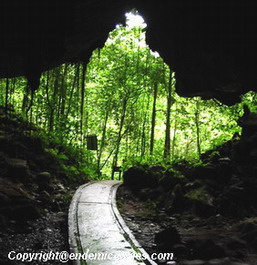
Deer Cave is
home to many species of bats. If the weather is fine, visitors
may be treated to the spectacular sight of a black cloud of
free-tailed bats merging from the entrance of the cave to go in
search of food between 5 and 7pm. Initially, this cloud was
thought to contain hundreds of thousands of bats, but recently
according to a study it was known that the figure is well over
1.3 millions. These bats help to control pests on crops around
the vicinity of the caves. They get rid of insects like
mosquitoes. It was estimated that each bat could eat 10gms of
insects or fruits per day.
There is a path leads into the cave and winds its way
around, follow the natural contours of the cave floor. This path
eventually leads to the "Garden of Eden" where a hole in the
cave roof lets in a shaft of light, which allows the rich green
vegetation to thrive. Another feature is the famous profile of
Abraham Lincoln, which guards the southern entrance of the cave.
A visit to Deer Cave is usually combined with one to Lang's
Cave, whose entrance is a short distance away from that of Deer
Cave. Lang's Cave is the smallest of the show caves but its rock
formations are well worth seeing. These are more attractive, as
all are strategically positioned spotlights, which highlight
stalactites and stalagmites.
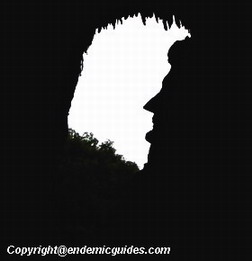
Clearwater
Cave & Wind Cave
Clearwater
Cave is Asia's longest cave and also rated as 7th
longest cave passage in the world. It measures 107km. It has a
subterranean river, part of which is navigable by boat.
There are two ways to access Clearwater Cave. First, you
can trek a 4 km nature trail, which takes about one and half
hours. Alternatively, you can take the longboat cruise along
the Melinau River where it stops at Wind Cave. This usually
take 15 minutes but, if the water level is low, the journey
might takes longer as the boatman often has to jump out of the
boat and push.
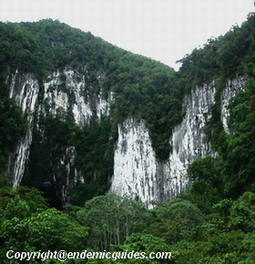
Wind Cave, which is part of the Clearwater Cave system, has
many impressive stalactites, stalagmites, flowrocks, helitites
and rock corals, some of which are illuminated in the 'King's
Room.'
After visiting these caves, visitors can climb down the
steps to the picnic area. There is a crystal clear pool at the
area filled by water that flows out from the caves which is an
excellent swimming spot. Visitors can also choose to relax on
the picnic benches and admire the rainforest scenery, or perhaps
watch the swarms of butterflies that are often found fluttering
around the riverbank. If you are lucky, you might see the Rajah
Brooke butterfly with its huge bright-green coloured wings.
The
Pinnacles
Mulu’s famous Pinnacles, which are a mid-way up the slopes
of Gunung Api, consist a series of 45 meters high, razor-sharp
limestone spikes that tower above the surrounding vegetation.
The trek to view them is one of the most popular in the park,
yet it is tough and challenging as the trail itself is very
steep and requires a certain level of fitness.
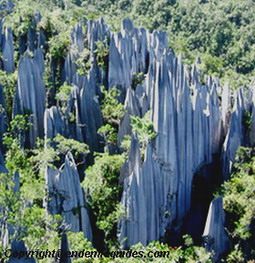
The
Headhunter's Trail
The Headhunter's Trail is a great way of entering or leaving
Gunung Mulu National Park.
The trek is organised by travel operators. It combines
upriver travel, jungle trekking and an overnight stay at an Iban
longhouse. The trail itself follows the route taken by Kayan
headhunting parties who paddled up the Melinau River to the
Melinau Gorge. From there, they dragged their longboats through
the forest for 3 km until they reached the banks of the Terikan
River, where they launched headhunting raids against the people
of the Limbang area.
The Headhunter's Trail can also be done in reverse, starting
from Limbang and ending up at the park HQ. Either way the trek
offers an excellent introduction to the rivers and rainforest of
Mulu and the added attraction of a longhouse visit. Visitors
have the option to climb the Pinnacles as part of their
Headhunter’s Trail package as the trek includes an overnight
stay at Camp 5.

Gunung Mulu
Summit Trek
The toughest trek in the park is the climb to the summit of
Gunung Mulu (2,376 m). It requires a high level of fitness. In
the 19th Centrury, two old ‘Borneo hands’, Spenser St
John and Charles Hose, attempted to conquer Mount Mulu, but
expedition failed. It was not until 1920’s, when Tama Nilong
discovered the ‘south-west’ ridge way to the summit. In 1932,
Tama Nilong led Lord Shackleton and an Oxford University
Expedition to the summit of Mulu.
Since then, the route discovered in 1920’s was used as the
trail to summit. The trek is usually done by a 4-day hike, but
experienced trekkers can do it in less. It involves overnight
stops at jungle camps. A number of wooden huts are positioned
along the trail, which provide shelter for overnight stops.
Trekkers should well prepare with good trekking shoes, sleeping
bag, food supplies, cooking utensils and sufficient water before
the trek. Along the trail, trekkers can experience the
rainforest and perhaps see some rare animals and birds,
including various species of Hornbill.
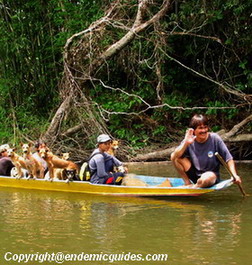
Facilities
Visitors are required to register at the Park HQ upon
arrival. There is a good information centre next to the
registration counter. Book your accommodation in advance. Bring
a raincoat, torch and camera flash along. Non-slip shoes are
essential as the trails are slippery. Plan for at least 2 days’
stay in the park to visit the cave system.
No camping equipment will be provided by the Park.
Therefore, bring your own sleeping bags (2 seasons) for Camp 5
are sufficient, but for the Summit Trail, warmer equipment is
recommended. Visitors who are going for Adventure Caving must
bring their own caving equipments, as the park does not supply
them. The Park HQ also has a canteen, which sells drinks and
meals.
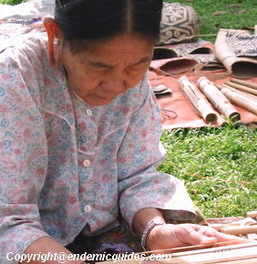
Getting there
You can access using the main gateway for Gunung Mulu
National Park at Miri, Northeast Flight is also available by
Malaysian Airlines, which operates scheduled services from Miri
to Mulu using a 19 seater Twin Otter aircraft. It takes
approximately 45 minutes to reach and you can get a very nice
bird view of the rainforest.
Alternatively, you can travel by boat at Marudi. However,
longboats must be chartered, as there is no regular boat service
on the last section of the trip.
Mulu National
Park Contacts:
Tel: (60) 85 434184 or 085 436637 (Miri)
Fax: (60) 85 417629
Back to Page 1 >>
Tour packages to Mulu National Park>>
|